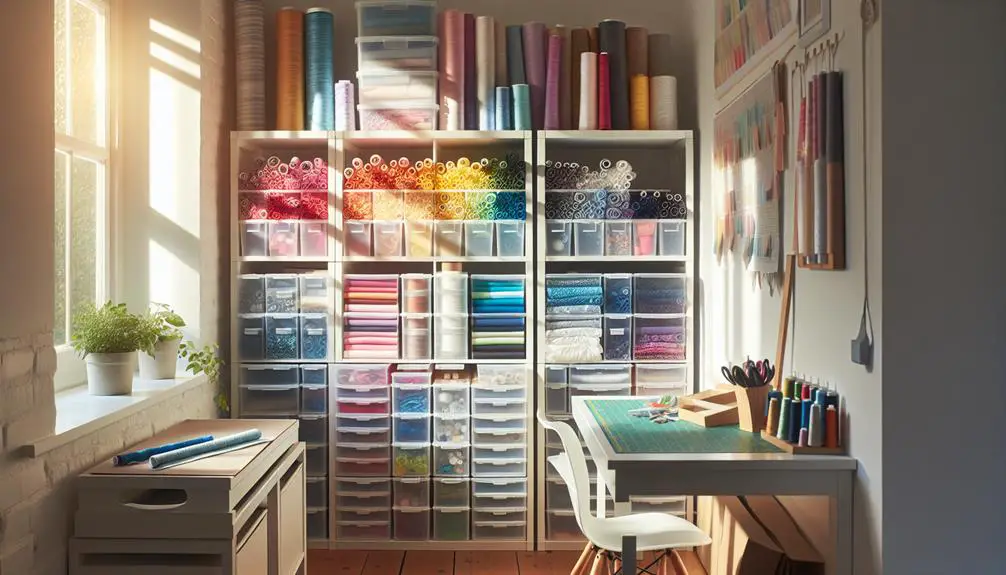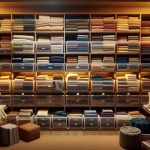When storing fabrics, you need to think about several factors to maintain their quality and longevity. Start by selecting a cool, stable environment with sufficient ventilation to prevent damage from fluctuating temperatures and mold. Using acid-free storage materials is vital to avoid deterioration. You also need to fold fabrics along their natural grains and keep them away from direct sunlight. Each fabric type requires specific care, and controlling humidity levels is important. But how do you make sure everything stays organized and protected from pests? Let's delve into the steps necessary for best fabric preservation.
Table of Contents
Key Takeaways
- Maintain consistent, moderate temperatures and proper ventilation to ensure fabric longevity.
- Use acid-free storage materials like boxes and tissue paper to prevent fabric deterioration.
- Fold fabrics along their natural grain to avoid creases and maintain integrity.
- Protect fabrics from direct sunlight using UV-blocking window films, shades, or dark containers.
- Keep relative humidity between 30% and 50% using hygrometers, dehumidifiers, or silica gel packets.
Choose the Right Environment
Choosing the right environment is important in maintaining the quality and longevity of your fabrics. One of the key factors to take into account is temperature control. Fabrics thrive in environments where temperatures are consistent and moderate. Fluctuating temperatures can cause fibers to expand and contract, leading to damage over time. Aim for a cool, stable environment to keep your fabrics in excellent condition.
Proper ventilation is another crucial element. Stale, stagnant air can promote mold and mildew growth, which can ruin your fabrics. Ensure that your storage space has sufficient air circulation. Avoid tightly sealed containers, unless they're designed to allow for breathability. When air can move freely, it helps prevent moisture buildup and keeps fabrics fresh.
In addition to temperature and ventilation, fabric rotation is essential. Regularly rotating your fabrics ensures that no single piece is subjected to prolonged pressure or exposure. This simple, yet effective practice can greatly prolong the life of your textiles. By rotating them and allowing air circulation, you help avoid creases and stress points.
Mastering these elements—temperature control, proper ventilation, and fabric rotation—will protect your fabrics, ensuring they remain beautiful and durable for years to come.
Utilize Acid-Free Storage
To further safeguard your fabrics, use acid-free storage materials to prevent chemical reactions that can cause deterioration. Acid-free options are crucial in fabric preservation because they guarantee that your textiles remain in pristine condition over the long term.
By selecting acid-free boxes, tissue paper, and storage bags, you're adopting storage solutions that protect against harmful acids that can weaken fibers and cause yellowing.
When you store fabrics, opting for acid-free materials isn't just a precaution—it's a necessity for maintaining their quality. Acid-free tissue paper can be used to wrap your fabrics, providing a protective barrier that minimizes contact with potentially damaging substances.
Acid-free storage boxes offer a stable environment, reducing the risk of fabric degradation over time.
Moreover, consider using acid-free garment bags for hanging items. These specialized storage solutions prevent your fabrics from coming into contact with acidic materials that could compromise their integrity.
Fold Fabrics Correctly
When you fold fabrics correctly, you prevent unsightly creases and make the most of your storage space. Proper folding also helps maintain the fabric's integrity over time.
Preventing Fabric Creases
Folding fabrics correctly guarantees they remain crease-free and ready for use. Mastering the art of folding will not only enhance wrinkle prevention but also extend the life of your cherished materials. Begin by treating fabrics with steam treatment, which relaxes fibers and minimizes creases. Next, lay the fabric on a flat surface and smooth out wrinkles with your hands.
Here's a quick guide to folding different types of fabric:
| Fabric Type | Folding Method | Tips |
|---|---|---|
| Cotton | Tri-fold | Use steam to ease creases |
| Silk | Roll | Avoid sharp folds |
| Linen | Square fold | Fold along natural lines |
| Wool | Flat fold | Store in breathable bags |
| Synthetic | Z-fold | Keep away from direct heat |
Folding fabrics along their natural grain helps in maintaining their structure and appearance. Avoid overloading storage spaces, as tightly packed fabrics are prone to creasing. For added wrinkle prevention, occasionally refold fabrics to redistribute pressure points. Additionally, using acid-free tissue between folds can help maintain shape and reduce creases. Remember, the right folding technique is your first line of defense against creases and guarantees your fabrics stay pristine.
Efficient Space Utilization
Maximizing storage capacity starts with mastering efficient fabric folding techniques. When you fold fabrics correctly, you're not just saving space; you're also ensuring easy access and maintaining order.
Start by folding each piece uniformly. This consistency plays an essential role in space efficiency, letting you stack fabrics neatly and making the most of your storage area.
To achieve this, lay your fabric flat on a clean surface. Fold it in half lengthwise, smoothing out any wrinkles. Then fold it again, aligning the edges precisely. For larger pieces, you might need a few extra folds, always aiming for a compact, uniform shape.
This method not only conserves space but also keeps your fabrics easily visible, aiding in quick fabric rotation.
Organize your fabrics by size and type, stacking similar dimensions together. This organization minimizes clutter and maximizes accessibility. Labeling your stacks can further enhance your system, allowing for swift identification and retrieval.
Maintaining Fabric Integrity
Proper folding methods are crucial for preserving your fabric's quality and durability. To maintain fabric integrity, always begin by cleaning the material. Dust and dirt can deteriorate fibers over time.
Next, make sure the fabric is completely dry to prevent mold and mildew. When folding, avoid sharp creases by using acid-free tissue paper, which supports the fabric and reduces stress on fibers.
For best fabric preservation, roll delicate materials like silk and lace around a cardboard tube covered in tissue paper. This approach avoids fold lines completely.
For heavier fabrics, such as wool or denim, fold them loosely and store them in breathable cotton bags or bins to allow air circulation. These storage solutions prevent mustiness and fabric degradation.
Consider your storage environment. Fabric care involves keeping materials in a cool, dry place away from direct sunlight, which can cause fading and weakening. Implement these storage tips: stack folded fabrics with the heaviest on the bottom and the lightest on top to avoid crushing delicate fibers.
Additionally, rotate your stored fabrics periodically to prevent permanent creases.
Master these techniques, and you'll optimize your fabrics remain in pristine condition, ready for your next project.
Avoid Direct Sunlight
Direct sunlight can cause fabrics to fade and weaken over time, so make sure to store them in a shaded area. Sunlight exposure is a primary culprit in diminishing the quality and longevity of your textiles. When fabrics are left in direct sunlight, the intense UV rays break down fibers, leading to discoloration and brittleness. To ensure top-notch fabric preservation, place your fabrics in a location shielded from direct light.
Utilize UV protection strategies to safeguard your fabrics. Installing UV-blocking window films or using shades and curtains can notably reduce the amount of UV light entering the room. This simple yet effective measure helps maintain the vibrancy and strength of your fabrics, making sure they remain in top condition for years to come.
When considering fabric storage, always opt for dark or opaque containers. Clear plastic bins may seem convenient, but they can still allow harmful light to penetrate and degrade the fabric. Instead, use containers that block light completely, providing an added layer of defense against UV damage.
Control Humidity Levels
Maintaining the right humidity levels is vital to prevent mold, mildew, and damage to your fabrics. You need to have a firm grasp on humidity control to guarantee your fabrics remain in pristine condition. Aim to keep relative humidity between 30% and 50%. Anything higher can foster mold growth, while lower levels can make fabrics brittle. Invest in a hygrometer to monitor these levels accurately.
Temperature regulation goes hand-in-hand with humidity control. Ideal storage temperatures hover between 60°F and 70°F. Extreme temperatures can wreak havoc on your fabric collection. High heat accelerates deterioration, while cold temperatures can make fabrics stiff and more susceptible to damage.
Don't rely on guesswork; use dehumidifiers in damp environments and humidifiers in overly dry settings. These tools will help you maintain a stable environment, essential for long-term fabric preservation.
Additionally, consider placing silica gel packets in storage areas. They're excellent for absorbing excess moisture and further aid in humidity control.
Use Protective Covers
When storing fabrics, you'll want to use protective covers to keep them in top condition. These covers prevent dust accumulation and shield your materials from harmful sunlight.
Prevent Dust Accumulation
Using protective covers is a simple yet effective way to prevent dust from settling on your stored fabrics. By keeping your fabrics covered, you'll avoid frequent and potentially damaging cleaning methods.
Here are some essential tips to master this important fabric storage solution:
- Choose Breathable Covers: Opt for covers made from materials like cotton or muslin. These allow air circulation, which is vital for fabric preservation techniques, preventing mold and mildew.
- Label Your Covers: Maintain impeccable fabric organization by labeling each cover. This ensures you can quickly locate and access your fabrics without unnecessary handling, preserving their quality.
- Inspect Regularly: Periodically check the condition of your protective covers. Dust and dirt can still find their way in, so regular inspections help keep your fabrics in pristine condition.
- Store in a Clean Environment: Your protective covers will only be effective if the storage area is clean. Vacuum and dust the storage space routinely, guaranteeing a dust-free environment for your fabrics.
Mastering these steps guarantees you're using the best fabric preservation techniques and fabric storage solutions. By preventing dust accumulation, you'll keep your fabrics in excellent condition, ready for any project when needed.
Shield From Sunlight
Direct sunlight can cause fabrics to fade and weaken over time, making it essential to shield them effectively. To ensure UV protection and fabric longevity, you should always use protective covers. These covers act as a barrier against harmful rays, maintaining the vibrant colors and structural integrity of your fabrics.
Here's a quick guide on how to shield your fabrics from sun exposure for optimal fabric preservation:
| Action | Description | Benefit |
|---|---|---|
| Use UV-protective covers | Covers with UV-resistant materials | Blocks harmful rays |
| Store in dark places | Avoid areas with direct sunlight exposure | Prevents fading and weakening |
| Rotate fabrics | Change the position of stored fabrics periodically | Even exposure, longer lifespan |
| Use window treatments | Install blinds or curtains in storage rooms | Reduces overall sun exposure |
Store by Fabric Type
Grouping fabrics by type ensures that each material is stored in the most suitable conditions for its preservation. When you categorize your fabrics, you're not just organizing; you're also maximizing their longevity through tailored fabric care. Implementing effective storage solutions for different fabric types will keep your stash in prime condition.
- Cotton and Linen: Store these breathable fabrics in a cool, dry place. Use acid-free tissue paper to prevent yellowing and maintain their crispness and freshness.
- Silk and Satin: These delicate fabrics require special attention. Store them in a dark, cool environment and wrap them in muslin or acid-free paper to avoid damage from light and moisture.
- Wool and Cashmere: Protect these luxurious materials by folding them with lavender sachets or cedar blocks to repel moths. Store them in breathable cotton bags to preserve their integrity.
- Synthetic Fabrics: Generally less sensitive, synthetics can be stored in plastic bins. Make sure they're clean and dry to prevent mold and mildew growth.
Regularly Inspect Fabrics
Make it a habit to periodically check your fabric collection for any signs of damage or deterioration. Regular inspections are essential in maintaining the integrity and quality of your fabrics.
Start by examining each piece for any discoloration, tears, or fraying edges. This proactive approach helps you catch potential issues early, ensuring your fabrics remain in excellent condition.
When inspecting quality, pay attention to the texture and strength of the fabric. Gently stretch the material to check for any weakening fibers. If you notice any unusual stiffness or brittleness, it may indicate that the fabric's condition is declining.
Adjust your storage frequency based on your findings. Fabrics stored in humid or fluctuating temperatures may require more frequent checks.
Additionally, make sure that the storage environment remains clean and dry. Dust and moisture can cause significant deterioration over time.
By consistently monitoring your fabrics, you'll be able to address minor issues before they escalate into major problems. Lay out your fabrics flat or roll them to prevent creases and folds, which can weaken the material.
Incorporate these regular inspections into your routine, and you'll master the art of fabric preservation. Your diligence will pay off, keeping your fabric collection pristine for years to come.
Keep Pests Away
Protecting your fabric collection against pests is vital to maintaining its quality and longevity. Fabric-loving pests like moths and beetles can wreak havoc if you don't take preventive measures. Here's how you can keep those unwanted guests at bay:
- Use Natural Repellents: Incorporate natural repellents such as lavender, cedar, and cloves into your fabric storage. These natural solutions are effective at deterring pests without introducing harmful chemicals. Place sachets of these repellents in your storage areas to maintain an aromatic barrier against insects.
- Store in Airtight Containers: For best fabric preservation, always use airtight containers. Pests can't infiltrate sealed environments, ensuring your fabrics remain untouched and pristine. Airtight containers also help in controlling humidity, which is essential for maintaining fabric integrity.
- Clean Fabrics Before Storing: Always clean your fabrics before storing them. Food stains, body oils, and dirt can attract pests. Even small residues can be a feast for insects, so guarantee all fabrics are thoroughly washed and dried before storage.
- Regularly Refresh Repellents: Natural repellents lose potency over time. To maintain their effectiveness, refresh your lavender, cedar, or clove sachets every few months. This upkeep ensures a consistently pest-free fabric storage environment.
Label Storage Containers
When you label storage containers, make sure the labels are clear and easy to read.
Use a consistent labeling method to avoid confusion and help you find what you need quickly.
This simple practice will save you time and keep your fabric collection organized.
Clear Container Labels
Labeling your clear storage containers is crucial for quickly identifying the fabrics you need without rummaging through piles. A well-thought-out organizing system improves your storage efficiency, saving you time and effort. When your containers are clearly labeled, you can streamline your container identification process, making your inventory management more effective.
To achieve mastery in labeling clear containers, follow these steps:
- Use Large, Readable Fonts: Make sure your labels are easy to read from a distance. This small detail can make a huge difference when you're in a hurry.
- Include Key Details: List fabric type, color, and yardage on each label. This detailed information helps you make quick decisions without unnecessary guesswork.
- Use Durable Labels: Invest in high-quality, weather-resistant labels that won't peel or fade over time. This durability ensures your organizing system remains intact.
- Color-Code Categories: Assign specific colors for different fabric types or projects. This visual cue can greatly enhance your storage efficiency.
Consistent Labeling Method
To maintain an organized fabric collection, adopt a consistent labeling method that guarantees all your storage containers are uniformly marked. This approach will boost your label organization and storage efficiency, making it much easier to locate and manage your fabrics. By labeling each container meticulously, you can streamline fabric identification and enhance your inventory management.
Your labels should include key details such as fabric type, color, and yardage. Consider using a label maker or printable labels to sustain uniformity. Consistency in your labeling method reduces the time spent searching for specific fabrics and assures that your collection stays neat and accessible.
Here's a sample table to guide your labeling:
| Fabric Type | Color | Yardage |
|---|---|---|
| Cotton | Blue | 3 yards |
| Linen | White | 5 yards |
| Silk | Red | 2 yards |
| Wool | Green | 4 yards |
| Polyester | Black | 6 yards |
Frequently Asked Questions
How Can I Prevent Fabric Colors From Fading Over Time?
To prevent fabric colors from fading, always wash with cold water and mild detergent. Avoid direct sunlight exposure. For best color preservation, use gentle cycles. These fabric care and longevity tips guarantee effective fading prevention.
What Are the Best Methods for Storing Delicate Lace Fabrics?
Think of delicate lace like a fragile butterfly; you need to handle it with care. Use lace preservation techniques like acid-free tissue paper and fabric storage solutions like breathable containers to guarantee your lace stays pristine.
Can I Use Vacuum-Sealed Bags for Long-Term Fabric Storage?
You can use vacuum-sealed bags for long-term fabric storage. They offer space-saving solutions and excellent fabric protection. However, guarantee moisture control to maintain fabric preservation, as trapped moisture can damage delicate materials over time.
How Do I Handle and Store Antique or Vintage Textiles?
When handling antique textiles, use delicate restoration techniques, store them in acid-free tissue, and avoid direct sunlight. Handle fragility with clean gloves, support the fabric evenly, and store in a cool, dry place to guarantee longevity.
What Are the Recommended Temperatures for Fabric Storage?
For ideal storage temperatures, keep fabrics between 60-70°F with humidity levels at 55%. Use fabric preservation techniques like acid-free tissue and proper ventilation. These tips guarantee your fabrics remain in pristine condition.
- How Does Ring Spun Cotton Affect Garment Fit and Shape Retention? - August 13, 2024
- What Are the Challenges in Producing Ring Spun Cotton? - August 13, 2024
- Is Ring Spun Cotton Suitable for Plus-Size Clothing? - August 13, 2024







